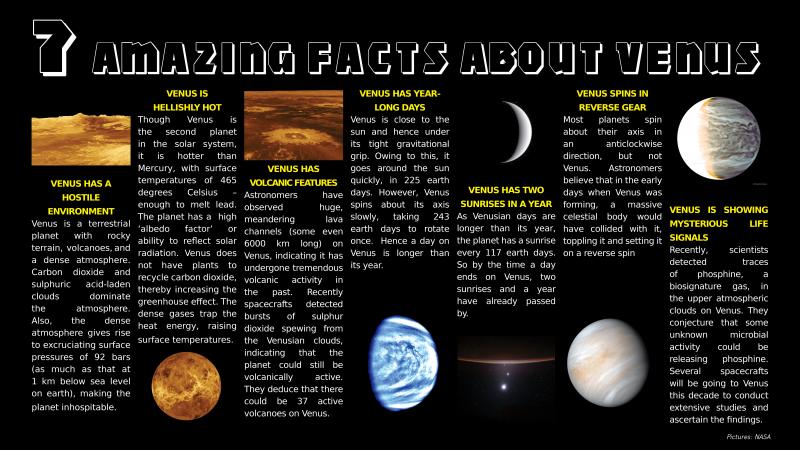
Venus has a hostile environment
Venus is a terrestrial planet with rocky terrain, volcanoes, and a dense atmosphere. Carbon dioxide and sulphuric acid-laden clouds dominate the atmosphere. Also, the dense atmosphere gives rise to excruciating surface pressures of 92 bars (as much as that at 1km below sea level on earth), making the planet inhospitable.
Venus is hellishly hot
Though Venus is the second planet in the solar system, it is hotter than Mercury, with surface temperatures of 465 degrees Celsius - enough to melt lead. The planet has a high ‘albedo factor’ or ability to reflect solar radiation. Venus does not have plants to recycle carbon dioxide, thereby increasing the greenhouse effect. The dense gases trap the heat energy, raising surface temperatures.
Venus has volcanic features
Astronomers have observed huge, meandering lava channels (some even 6000km long) on Venus, indicating it has undergone tremendous volcanic activity in the past. Recently spacecraft detected bursts of sulphur dioxide spewing from the Venusian clouds, indicating that the planet could still be volcanically active. They deduce that there could be 37 active volcanoes on Venus.
Venus has year-long days
Venus is close to the sun and hence under its tight gravitational grip. Owing to this, it goes around the sun quickly, in 225 earth days. However, Venus spins about its axis slowly, taking 243 earth days to rotate once. Hence a day on Venus is longer than its year.
Venus has two sunrises in a year
As Venusian days are longer than its year, the planet has a sunrise every 117 earth days. So by the time a day ends on Venus, two sunrises and a year have already passed by.
Venus spins in reverse gear
Most planets spin about their axis in an anticlockwise direction, but not Venus. Astronomers believe that in the early days when Venus was forming, a massive celestial body would have collided with it, toppling it and setting it on a reverse spin.
Venus is showing mysterious life signals
Recently, scientists detected traces of phosphine, a biosignature gas, in the upper atmospheric clouds on Venus. They conjecture that some unknown microbial activity could be releasing phosphine. Several spacecraft will be going to Venus this decade to conduct extensive studies and ascertain the findings.





